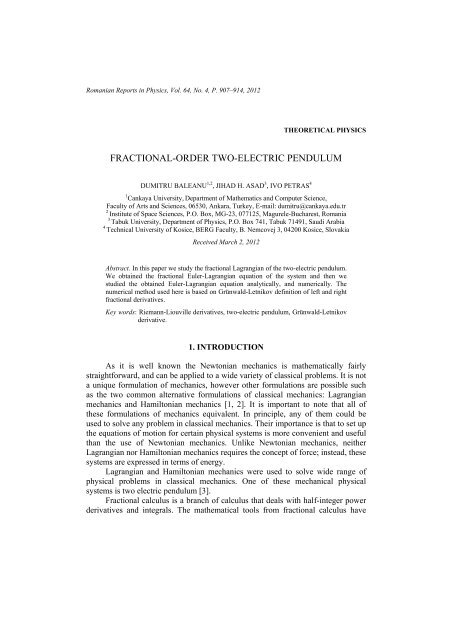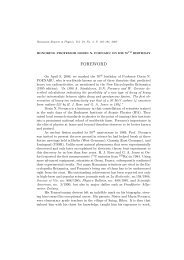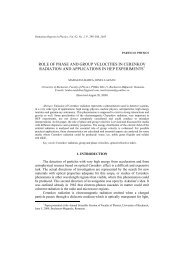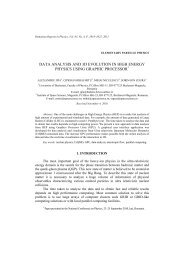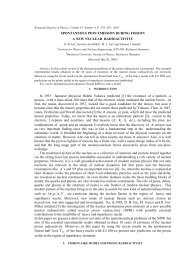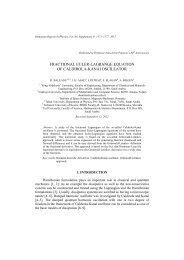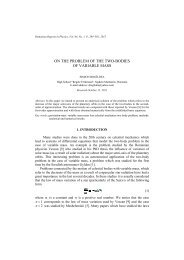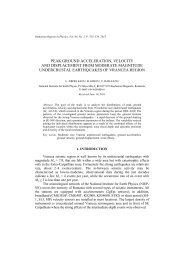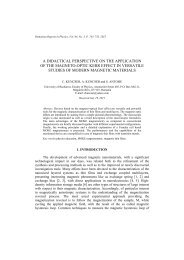View - Romanian Reports in Physics
View - Romanian Reports in Physics
View - Romanian Reports in Physics
You also want an ePaper? Increase the reach of your titles
YUMPU automatically turns print PDFs into web optimized ePapers that Google loves.
<strong>Romanian</strong> <strong>Reports</strong> <strong>in</strong> <strong>Physics</strong>, Vol. 64, No. 4, P. 907–914, 2012<br />
THEORETICAL PHYSICS<br />
FRACTIONAL-ORDER TWO-ELECTRIC PENDULUM<br />
DUMITRU BALEANU 1,2 , JIHAD H. ASAD 3 , IVO PETRAS 4<br />
1 Cankaya University, Department of Mathematics and Computer Science,<br />
Faculty of Arts and Sciences, 06530, Ankara, Turkey, E-mail: dumitru@cankaya.edu.tr<br />
2<br />
Institute of Space Sciences, P.O. Box, MG-23, 077125, Magurele-Bucharest, Romania<br />
3<br />
Tabuk University, Department of <strong>Physics</strong>, P.O. Box 741, Tabuk 71491, Saudi Arabia<br />
4<br />
Technical University of Kosice, BERG Faculty, B. Nemcovej 3, 04200 Kosice, Slovakia<br />
Received March 2, 2012<br />
Abstract. In this paper we study the fractional Lagrangian of the two-electric pendulum.<br />
We obta<strong>in</strong>ed the fractional Euler-Lagrangian equation of the system and then we<br />
studied the obta<strong>in</strong>ed Euler-Lagrangian equation analytically, and numerically. The<br />
numerical method used here is based on Grünwald-Letnikov def<strong>in</strong>ition of left and right<br />
fractional derivatives.<br />
Key words: Riemann-Liouville derivatives, two-electric pendulum, Grünwald-Letnikov<br />
derivative.<br />
1. INTRODUCTION<br />
As it is well known the Newtonian mechanics is mathematically fairly<br />
straightforward, and can be applied to a wide variety of classical problems. It is not<br />
a unique formulation of mechanics, however other formulations are possible such<br />
as the two common alternative formulations of classical mechanics: Lagrangian<br />
mechanics and Hamiltonian mechanics [1, 2]. It is important to note that all of<br />
these formulations of mechanics equivalent. In pr<strong>in</strong>ciple, any of them could be<br />
used to solve any problem <strong>in</strong> classical mechanics. Their importance is that to set up<br />
the equations of motion for certa<strong>in</strong> physical systems is more convenient and useful<br />
than the use of Newtonian mechanics. Unlike Newtonian mechanics, neither<br />
Lagrangian nor Hamiltonian mechanics requires the concept of force; <strong>in</strong>stead, these<br />
systems are expressed <strong>in</strong> terms of energy.<br />
Lagrangian and Hamiltonian mechanics were used to solve wide range of<br />
physical problems <strong>in</strong> classical mechanics. One of these mechanical physical<br />
systems is two electric pendulum [3].<br />
Fractional calculus is a branch of calculus that deals with half-<strong>in</strong>teger power<br />
derivatives and <strong>in</strong>tegrals. The mathematical tools from fractional calculus have
908<br />
Dumitru Baleanu, Jihad H. Asad, Ivo Petras<br />
2<br />
been used widely to study many phenomena <strong>in</strong> eng<strong>in</strong>eer<strong>in</strong>g, physics, as well as <strong>in</strong><br />
other sciences [4–13]. The formulation of the fractional Euler-Lagrange problem<br />
has been recently drew the attention of many authors <strong>in</strong> their works [14–19].<br />
Particularly, f<strong>in</strong>d<strong>in</strong>g the numerical solutions of the equations <strong>in</strong>volv<strong>in</strong>g the left and<br />
right derivatives is still an open problem <strong>in</strong> the field of the fractional dynamics [see<br />
for Ref. 19 and the references there<strong>in</strong>].<br />
Numerical analysis of fractional differential equations has been used by many<br />
authors to solve wide ranges of differential equations [20–25]. In his recent work,<br />
Podlubny [26, 27] shows how we can numerically <strong>in</strong>vestigate differential equations<br />
us<strong>in</strong>g the so-called matrix approach method.<br />
Hav<strong>in</strong>g these th<strong>in</strong>gs <strong>in</strong> m<strong>in</strong>d, <strong>in</strong> this paper, we pay attention to study<br />
numerically the fractional Euler-Lagrange equation of a mechanical physical<br />
system called two electric pendulum.<br />
This work is organized as follows:<br />
In Sect. 2 we discussed briefly the basic def<strong>in</strong>itions of the fractional<br />
derivatives. In Sect. 3 we study the fractional two electric pendulum model. In<br />
Sect. 4 numerical analysis of the obta<strong>in</strong>ed Euler-Lagrange equation of our model is<br />
carried out. F<strong>in</strong>ally, we closed our paper with conclud<strong>in</strong>g remarks.<br />
2. BASIC DEFINITIONS<br />
In this section we discussed the def<strong>in</strong>itions of the fractional derivatives (left<br />
and right Riemann-Liouville fractional derivatives). These def<strong>in</strong>itions are used <strong>in</strong><br />
the Hamiltonian formulation and the solution of examples lead<strong>in</strong>g to the equations<br />
of motion of the fractional order. The left Riemann-Liouville fractional <strong>in</strong>tegral<br />
(LRLFI) is def<strong>in</strong>ed as follows [8, 9]:<br />
t<br />
α<br />
1<br />
α−1<br />
a t<br />
= −<br />
(α)<br />
a<br />
I x() t ( t τ) x(τ)dτ<br />
Γ ∫<br />
(1)<br />
The right Riemann-Liouville fractional <strong>in</strong>tegral (RRLFI) has the form<br />
b<br />
α<br />
1<br />
α−1<br />
t b<br />
= −<br />
(α)<br />
t<br />
I x() t (τ t) x(τ)dτ<br />
Γ ∫<br />
. (2)<br />
The left Riemann-Liouville fractional derivative (LRLFD) reads<br />
n x<br />
α<br />
1 ⎛ d ⎞ f (τ)<br />
aDx f x =<br />
α− n+<br />
1<br />
Γ( n−α) ⎜<br />
d x<br />
⎟<br />
( x−τ)<br />
a<br />
( ) ∫ dτ. (3)<br />
⎝ ⎠<br />
The right Riemann-Liouville fractional derivative (RRLFD) reads
3 Fractional-order two-electric pendulum<br />
909<br />
b<br />
α<br />
1 d<br />
n<br />
f (τ)<br />
xDb f x = −<br />
α n 1<br />
Γ( n−α) d x (τ − x)<br />
− +<br />
x<br />
( ) ( )<br />
∫<br />
dτ. (4)<br />
Here α is the order of the derivative such that n −1≤α≤ n and is not equal to<br />
zero. If α is an <strong>in</strong>teger, these derivatives are def<strong>in</strong>ed <strong>in</strong> the usual sense, i.e.,<br />
x<br />
a<br />
D f x<br />
α<br />
x<br />
=<br />
d<br />
dx<br />
f x<br />
α<br />
( ) ( ) ( )<br />
α<br />
d<br />
α<br />
Db<br />
f( x) = ( − ) f( x)<br />
; α= 1,2,... . (5)<br />
dx<br />
3. THE MODEL<br />
The model of the two electric pendulum consists of two planar pendula, both<br />
of length l and mass m suspended a distance d apart on a horizontal l<strong>in</strong>e so that<br />
they sw<strong>in</strong>g <strong>in</strong> the same plane. The k<strong>in</strong>etic energy is given by:<br />
1<br />
2 2<br />
T = m ( q1 + q 2 ) , (6)<br />
2<br />
where q 1 and q 2 denotes the correspond<strong>in</strong>g coord<strong>in</strong>ates.<br />
Potential energy is the sum of two terms; one gravitational, the other is an<br />
electrostatic, and they are written successively as:<br />
1 mg<br />
2 2<br />
UG<br />
= ( q1 + q2)<br />
, (7)<br />
2 l<br />
where g is the gravity constant.<br />
2<br />
e<br />
U<br />
E<br />
= , (8)<br />
d + q2 − q1<br />
where e is the electron charge. As a result, the entire Lagrangian function is:<br />
2<br />
1<br />
2 2<br />
1 mg<br />
2 2<br />
e<br />
L= m( q1 + q 2) − ( q1 + q2)<br />
−<br />
2 2 l d + q2 − q1<br />
. (9)<br />
The fractional form of the above equation has the follow<strong>in</strong>g form:<br />
2<br />
F<br />
1<br />
α 2<br />
1<br />
α 2<br />
1 mg<br />
2 2<br />
e<br />
L = m[ aDt q1] + m[ aDt<br />
q2] − ( q1 + q2)<br />
−<br />
2 2 2 l d + q2 − q1<br />
. (10)<br />
Now, to obta<strong>in</strong> Euler-Lagrange equations for the generalized coord<strong>in</strong>ates ( q1, q<br />
2)<br />
we use:
910<br />
Dumitru Baleanu, Jihad H. Asad, Ivo Petras<br />
4<br />
Thus, for qi<br />
= q1<br />
, we get:<br />
while, for qi<br />
= q2<br />
, we get:<br />
∂ L L L<br />
+ ∂ + ∂ = 0 . (11)<br />
∂q ∂ D q ∂ Dq<br />
α<br />
β<br />
tDb α aDt<br />
β<br />
i a t i t b i<br />
2<br />
g 1 e<br />
D D q − q − = 0 , (12a)<br />
α α<br />
t b a t 1 1 2<br />
l m ( d + q2 −q1)<br />
2<br />
g 1 e<br />
D D q − q + = 0 . (12b)<br />
α α<br />
t b a t 2 2 2<br />
l m ( d + q2 −q1)<br />
As α→ 1, we obta<strong>in</strong> the follow<strong>in</strong>g two classical Euler-Lagrange equations<br />
2<br />
g e<br />
q + q + = 0 , (13a)<br />
1 1 2<br />
l m( d + q2 −q1)<br />
2<br />
g<br />
e<br />
q + q − = 0 . (13b)<br />
2 2 2<br />
l m( d + q2 −q1)<br />
Our aim is to obta<strong>in</strong> a numerical solution for Eqs. (11a, and 11b) for arbitrary<br />
values of ,, , mld and for arbitrary boundary conditions for different values of α.<br />
4. NUMERICAL RESULTS OF FRACTIONAL LAGRANGIAN<br />
OF TWO-ELECTRIC PENDULUM<br />
For numerical solution of the l<strong>in</strong>ear fractional-order equations (12a) and<br />
(12b) we can use the decomposition to its canonical form with substitutions q1 ≡ x1<br />
and q2 ≡ x2. We obta<strong>in</strong> the set of equation <strong>in</strong> the form:<br />
a<br />
t<br />
a<br />
t<br />
D x = x ,<br />
α<br />
t<br />
D x<br />
α<br />
b<br />
D x<br />
α<br />
t<br />
1 3<br />
g 1<br />
=− x −<br />
3 1 2<br />
l m ( d + x2 − x1)<br />
= x<br />
2 4<br />
,<br />
g<br />
1<br />
2<br />
α<br />
b 4<br />
=− x2 +<br />
2<br />
l m ( d + x2 − x1)<br />
D x<br />
e<br />
e<br />
2<br />
,<br />
,<br />
(14)
5 Fractional-order two-electric pendulum<br />
911<br />
where we can set four <strong>in</strong>itial conditions: x1(0) ≡ q1(0), x2(0) ≡ q2(0)<br />
and<br />
x (0) ≡ D q (0), x (0) ≡ D q (0) . Instead left and right side Riemann-Liouville<br />
α<br />
α<br />
3 a t 1 4 a t 2<br />
fractional derivatives (3) and (4) <strong>in</strong> the set of equations (14) can be used the left<br />
and right Grünwald-Letnikov derivatives, which are equivalent to the Riemann-<br />
Liouville fractional derivatives for a wide class of the functions [8]. The Grünwald-<br />
Letnikov derivatives can be def<strong>in</strong>ed by us<strong>in</strong>g upper and lower triangular strip<br />
matrices (Podlubny’s matrix approach) or we can directly apply the formula<br />
derived from the Grünwald-Letnikov def<strong>in</strong>itions, backward and forward,<br />
respectively, for discrete time step kh, k = 1, 2, 3, … Le us consider the second<br />
approach, which works very well for l<strong>in</strong>ear as well as for nonl<strong>in</strong>ear fractional<br />
differential equations [28]. Time <strong>in</strong>terval [a, b] is discretized by (N + 1) equal grid<br />
po<strong>in</strong>ts, where N = ( b− a) / h. Thus, we obta<strong>in</strong> the follow<strong>in</strong>g formula for discrete<br />
equivalents of left and right fractional derivatives:<br />
k<br />
α − α<br />
a t k ∑ i k−i<br />
i=<br />
0<br />
D x = h c x , k = 0,..., N,<br />
N−k<br />
α −α<br />
t b k ∑ i k+<br />
i<br />
i=<br />
0<br />
D x = h c x , k = N,..., 0,<br />
(15a)<br />
(15b)<br />
respectively, where xk<br />
≈ xt (<br />
k)<br />
and tk<br />
= kh. The b<strong>in</strong>omial coefficients c<br />
i<br />
,<br />
i = 1, 2, 3,…, can be calculated accord<strong>in</strong>g to relation<br />
c<br />
i<br />
⎛ 1 + α ⎞<br />
= ⎜1<br />
− ⎟c<br />
⎝ i ⎠<br />
i−1<br />
, (16)<br />
for c<br />
0<br />
= 1. Then, general numerical solution of the fractional l<strong>in</strong>ear differential<br />
equation with left side derivative <strong>in</strong> the form<br />
a<br />
α<br />
D xt ( ) = f( xt ( ), t)<br />
t<br />
(17)<br />
can be expressed for discrete time t k<br />
= kh <strong>in</strong> the follow<strong>in</strong>g form:<br />
k<br />
α<br />
x( t ) f( x( t ), t ) h c x( t −<br />
), (18)<br />
= −∑<br />
k k k i k i<br />
i=<br />
m<br />
where m = 0 if we do not use a short memory pr<strong>in</strong>ciple, otherwise it can be related<br />
to memory length. Similarly we can derive a solution for an equation with right<br />
side fractional derivative.<br />
Let us consider the different value of order α for simulation time 2 sec and<br />
time step h = 0.0005. The parameters set up are the follow<strong>in</strong>g: m = 1 kg, l = 1 m, d = 1m.
912<br />
Dumitru Baleanu, Jihad H. Asad, Ivo Petras<br />
6<br />
Fig. 1 – Simulation results for various parameters and orders.<br />
In Fig. 1 are depicted the simulation results of equation (14) for parameters<br />
m=1kg, l=1m, d=1m, and various order α, where derivative <strong>in</strong>terval is a=0 and<br />
b=2, <strong>in</strong>itial conditions q 1 (0)=0.01, q 2 (0)=0.015, α th derivatives of q 1 (0) and q 2 (0)<br />
are zeros, for total simulation time 2 sec and computational time step h = 0.0005.<br />
5. CONCLUSIONS<br />
The fractional Euler-Lagrange equations have the particularity that they<br />
conta<strong>in</strong> both the left and the right derivatives. These k<strong>in</strong>d of equations started<br />
recently to be analyzed both from theoretical and numerically po<strong>in</strong>t of views. In<br />
this manuscript the numerical solutions of the fractional Euler-Lagrange equations<br />
correspond<strong>in</strong>g to the fractional electric model are presented for various values of α.
7 Fractional-order two-electric pendulum<br />
913<br />
Acknowledgments. The work of Ivo Petras was supported <strong>in</strong> part by grants VEGA: 1/0729/12,<br />
1/0497/11, 1/0746/11.<br />
REFERENCES<br />
1. J. B. Marion, S. T. Thornton, Classical Dynamics of Particles and Systems, Third Edition, Harcourt<br />
Brace Jovanovich, 1988.<br />
2. H. Goldste<strong>in</strong>, C. P. Poole, J. L. Safko, Classical Mechanics, Third Edition, Addison Wesley, 1980.<br />
3. *** www.math.uchicago.edu/~may/VIGRE/VIGRE2009/.../Tolish.pdf<br />
4. R.L. Bagley, P.J. Torvik, A theoretical basis for the application of fractional calculus to<br />
viscoelasticity, J. Rheol., 27, 201–210 (1983).<br />
5. F. Ma<strong>in</strong>ardi, On the Initial Value Problem for the Fractional Diffusion-wave Equations, <strong>in</strong>:<br />
S. Rionero and T. Ruggeri (eds.); Waves and Stability <strong>in</strong> Cont<strong>in</strong>uous Media, Word Scientific,<br />
S<strong>in</strong>gapore, 1994, pp. 246–251.<br />
6. F. Ma<strong>in</strong>ardi, The Fundamental Solutions for the Fractional Diffusion-wave Equation, Appl. Math.<br />
Lett., 9, 6, 23–28 (1996).<br />
7. A.A. Kilbas, H. M. Srivastava, J. J. Trujillo, Theory and Applications of Fractional Differential<br />
Equations, North-Holland Mathematics Studies, Vol. 204, North-Holland, Amsterdam 2006.<br />
8. I. Podlubny, Fractional Differential Equations, Academic Press, San Diego, 1999.<br />
9. S. G. Samko, A.A. Kilbas, O. I. Marichev, Fractional Integrals and Derivatives: Theory and<br />
Applications, Gordon and Breach, Yverdon, 1993.<br />
10. D. Baleanu, S. I. Muslih, E. M. Rabei, Golmankhaneh, Alireza K, Golmankhaneh, Ali K, On<br />
fractional Hamiltonian systems possess<strong>in</strong>g first-class constra<strong>in</strong>ts with<strong>in</strong> Caputo derivatives,<br />
Rom. Rep. Phys., 63, 1, 3 (2011).<br />
11. D. Baleanu, S. I. Vacaru, Fedosov quantization of fractional Lagrange spaces, Int. J. Theor.<br />
Phys., 50, 1, 233 (2011).<br />
12. S. I. Muslih, S. Madhat, D. Baleanu,E.M. Rabei, Lagrangian formulation of Maxwell's field <strong>in</strong><br />
fractional D dimensional space-time, Rom. J. Phys., 55, 7–8, 659 (2010).<br />
13. R. R. Nigmatull<strong>in</strong>, D. Baleanu, Is it possible to derive Newtonian equations of motion with<br />
memory?, Int. J. Theor. Phys., 49, 4, 701 (2010).<br />
14. F. Riewe, Nonconservative Lagrangian and Hamiltonian mechanics, Phys. Rev., E 53, 1890 (1996).<br />
15. O. P. Agrawal, Formulation of Euler–Lagrange equations for fractional variational problems,<br />
J. Math. Anal., Appl., 272, 368 (2002).<br />
16. D. Baleanu, J. J. Trujillo, On exact solutions of a class of fractional Euler-Lagrange equations,<br />
Nonl<strong>in</strong>ear Dynamics, 52, 4,331 (2007).<br />
17. M. Klimek, Lagrangian and Hamiltonian fractional sequential mechanics, Czech. J. Phys., 52,<br />
1247 (2002).<br />
18. D. Baleanu, T. Avkar, Lagrangians with l<strong>in</strong>ear velocities with<strong>in</strong> Riemann-Liouville fractional<br />
derivatives, Nuovo Cim., B 119, 73 (2004).<br />
19. D. Baleanu, K. Diethelm, E. Scalas, J.J. Trujillo, Fractional Calculus Models and Numerical<br />
Methods, Series on Complexity, Nonl<strong>in</strong>earity and Chaos, World Scientific, 2012.<br />
20. P. Kumar, O.P. Agrawal, An approximate method for numerical solution of fractional differential<br />
equations, Signal Proc., 86, 10, 234 (2006).<br />
21. R. Scherer, S. L. Kalla, Y. Tang, J. Huang, The Grünwald-Letnikov method for fractional<br />
differential equations, Comput. Math. Appl., 62, 3, 432 (2011).<br />
22. D. Baleanu, I. Petras, J. H. Asad, M. P. Velasco, Fractional Pais–Uhlenbeck Oscillator, Int. J.<br />
Theor. Phys., 2012; doi: 10.1007/s10773-011-1000-y.
914<br />
Dumitru Baleanu, Jihad H. Asad, Ivo Petras<br />
8<br />
23. K. Diethelm, N. J. Ford, Numerical solution of the Bagley-Torvik equation, BIT, 42, 3, 490<br />
(2002).<br />
24. S.S. Ray, R. K. Bera, Analytical solution of the Bagley Torvik equation by Adomian<br />
decomposition method, Appl. Math. Comput., 168, 1, 398 (2005).<br />
25. K. Diethelm, N.J. Ford, A.D. Freed, Yu. Luchko, Algorithms for the fractional calculus: A<br />
selection of numerical methods, Comput. Methods Appl. Mech. Engr., 194, 743 (2005).<br />
26. I. Podlubny, Matrix approach to discrete fractional calculus, Fract. Calcul. Appl. Anal., 3, 4, 359<br />
(2010).<br />
27. I. Podlubny, A.V. Chechk<strong>in</strong>, T. Skovranek, Y. Q. Chen, B. V<strong>in</strong>agre, Matrix approach to discrete<br />
fractional calculus II: partial fractional differential equations, J. Comput. Phys., 228, 8, 3137<br />
(2009).<br />
28. I. Petras, Fractional-Order Nonl<strong>in</strong>ear Systems: Model<strong>in</strong>g, Analysis and Simulation, Series:<br />
Nonl<strong>in</strong>ear Physical Science, Spr<strong>in</strong>ger, HEP, London, 2011.


